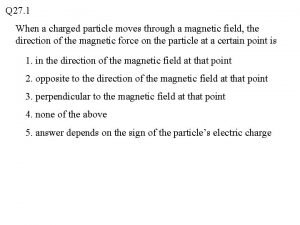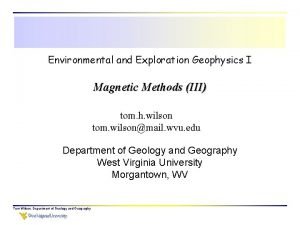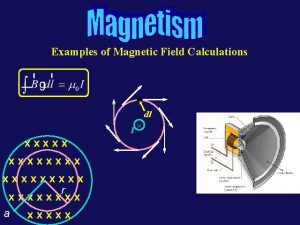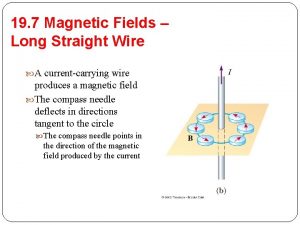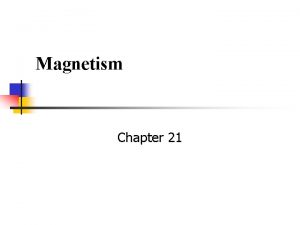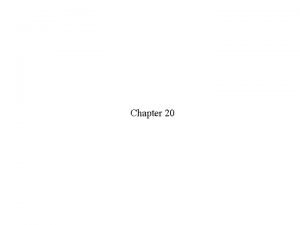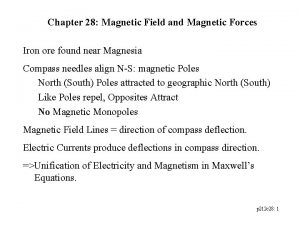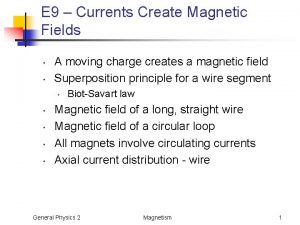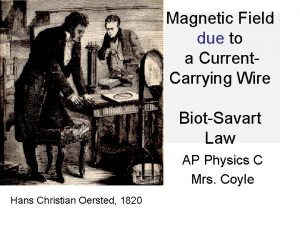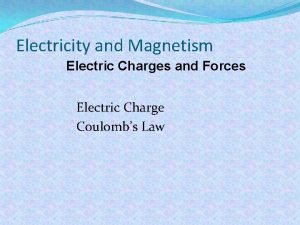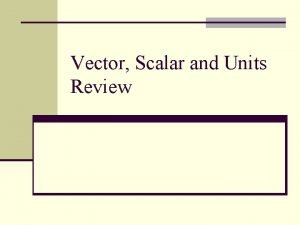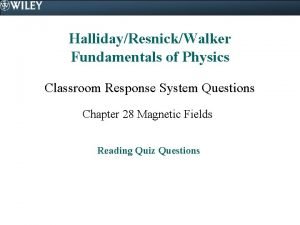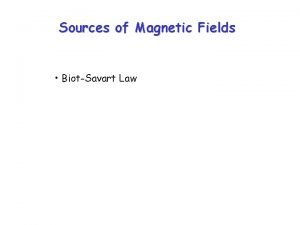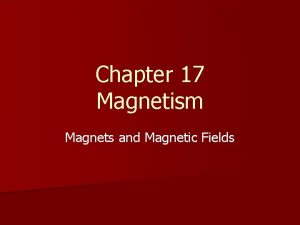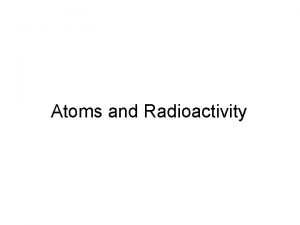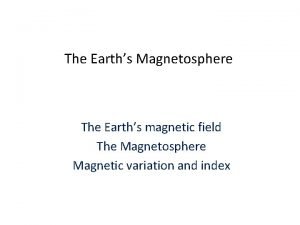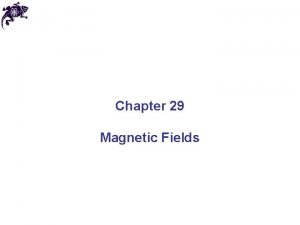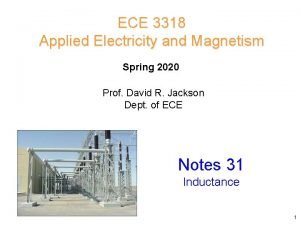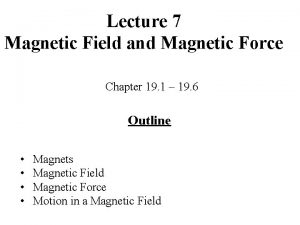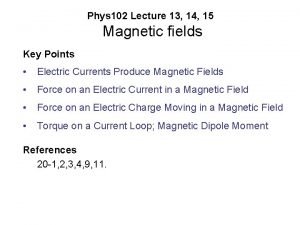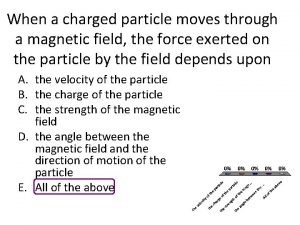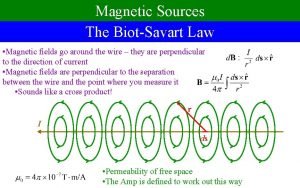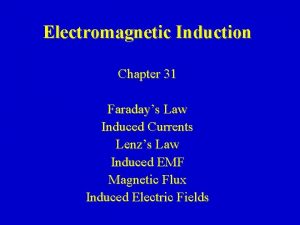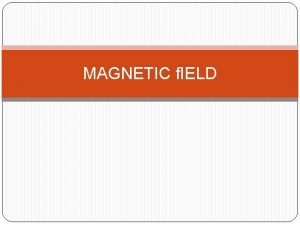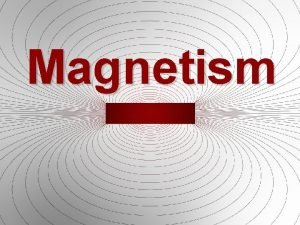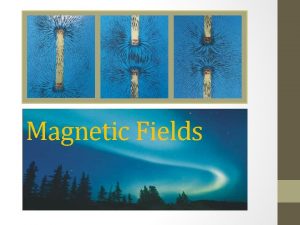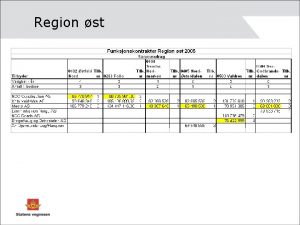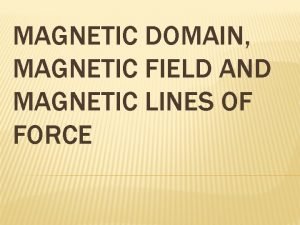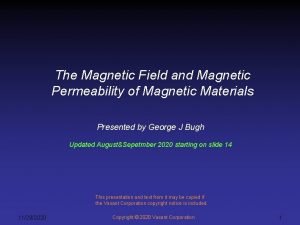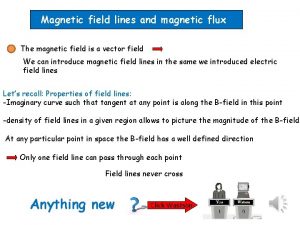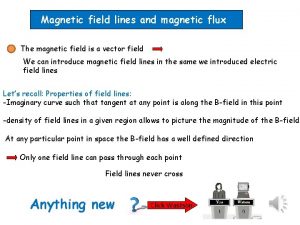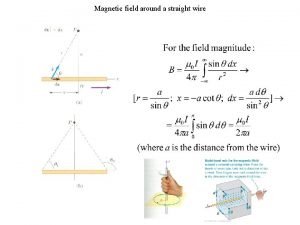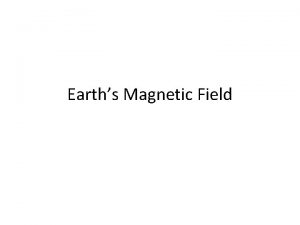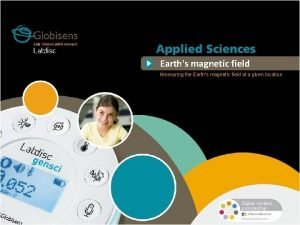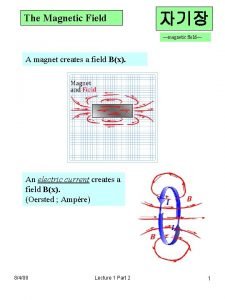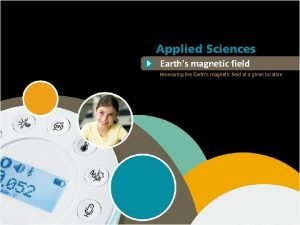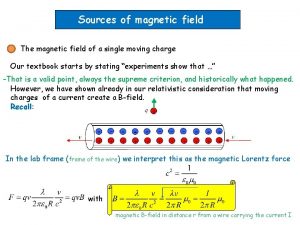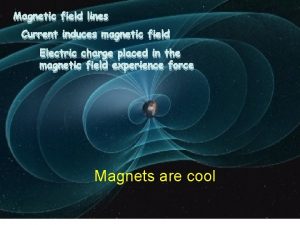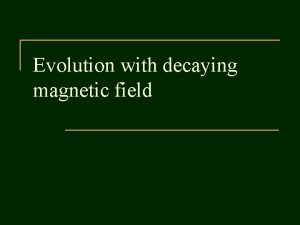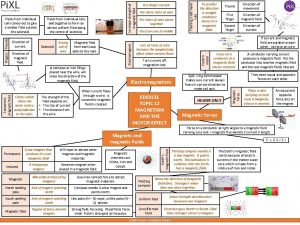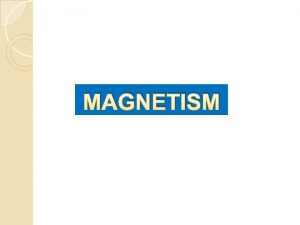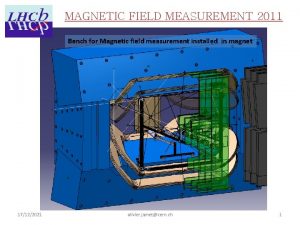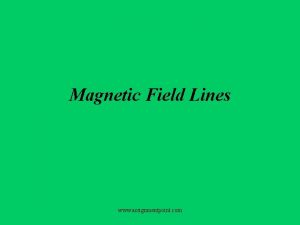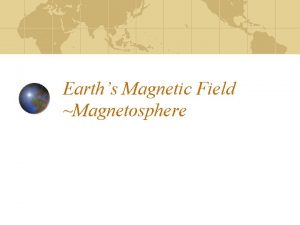Magnetic Field A magnetic field is a region







































- Slides: 39

Magnetic Field • A magnetic field is a region in which a body with magnetic properties experiences a force.

Sources of Magnetic Field • Magnetic fields are produced by electric currents, which can be macroscopic currents in wires, or microscope currents associated with electrons in atomic orbits.

Magnetic Field Lines • A magnetic field is visualised using magnetic lines of force which are imaginary lines such that the tangent at any point gives the direction of the magnetic field at that point.

Magnetic Flux Pattern

The Earth’s Magnetic Field • The Earth's magnetic field appears to come from a giant bar magnet, but with its south pole located up near the Earth's north pole.

Properties of Magnetic Field Lines • Magnetic lines of force never intersect. • By convention, magnetic lines of force point from north to south outside a magnet (and from south to north inside a magnet). • Field lines converge where the magnetic force is strong, and spread out where it is weak. (Number of

Magnetic flux pattern due to current in a straight wire at right angles to a uniform field Net flux is greater on this side of the wire Net flux is lesser on this side of the wire I

Fleming’s Left Hand Rule • If you point your left forefinger in the direction of the magnetic field, and your second finger in the direction of the current flow, then your thumb will point naturally in the direction of the resulting

Force on a current-carrying conductor • The direction of magnetic force always perpendicular to the direction of the magnetic field and the direction of current passing through the conductor.

Magnetic Flux Density • The magnetic flux density is defined as the force per unit length per unit current acting on a current-carrying conductor at right angle to the field lines. Unit : tesla (T) or gauss (G), 1 G = 10 -4 T or weber/m 2

Typical Values of the magnetic flux density Source B-Field (Tesla) Human Brain 10 -12 Interstellar Space 10 -10 Near Household Wiring 10 -4 Sunlight 3 x 10 -5 Earth's Magnetic Field at Pole 5 x 10 -4 Sunspots . 3 Largest man-made Magnet 5. 0 Surface of a Nucleus 106

Magnetic Field Measurements • Using a current balance (d. c. ) • Using a search coil (a. c. ) • Using a Hall probe (d. c. )

Magnetic flux density due to a straight wire • Experiments show that the magnetic flux density at a point near a long straight wire is r P • TThis relationship is valid as long as r, the perpendicular distance to the wire, is much less than the distance to the ends of the wire.

Calculation of B near a wire Where o is called the permeability of free space. Permeability is a measure of the effect of a ma on the magnetic field by the material.

Magnetic Field due to a Solenoid • The magnetic field is strongest at the centre of the solenoid and becomes weaker outside.

Magnetic Flux Density due to a Solenoid • Experiments show that the magnetic flux density inside a solenoid is and So we have or where

Variation of magnetic flux density along the axis of a solenoid • B is independent of the shape or area of the cross-section of the solenoid. B the end of the solenoid, • At a point at 0 Distance from the centre of the solenoid

Magnetic Flux Density due to Some Current-carrying conductors(1) • Circular coil • Helmholtz coils

Magnetic Flux density due to Some Current-carrying Conductors (2)

Force on a moving charge in a magnetic field • The force on a moving charge is proportional to the component of the magnetic field perpendicular to the direction of the velocity of the charge and is in a direction perpendicular to both the velocity and the field. http: //webphysics. davidson. edu/physlet_resources/bu_semester 2/c 12_force. html

Right Hand Rule • Direction of force on a positive charge given by the right hand rule.

Free Charging Moving in a Uniform Magnetic Field • If the motion is • In general, with exactly at right the motion angles to a inclined to the uniform field, the path is turned helix round the into a circle. lines of force.

Mass Spectrometer • The mass spectrometer is used to measure the masses of atoms. • Ions will follow a straight line path in this region. • Ions follow a circular path in this region.

Aurora Borealis (Northern Lights) • Charged ions approach the Earth from the Sun (the “solar wind” and are drawn toward the poles, sometimes causing a phenomenon called the aurora borealis.

Causes of Aurora Borealis • The charged particles from the sun approaching the Earth are captured by the magnetic field of the Earth. • Such particles follow the field lines toward the poles. • The high concentration of charged particles http: //www. exploratorium. edu/learning_studio/auroras/selfguide 1. html ionizes the air and

Hall Effect • When a current carrying conductor is held firmly in a magnetic field, the field exerts a sideways force on the charges moving in the conductor. • A buildup of charge at the sides of the conductor produces a measurable voltage between the two sides of the • The presence of conductor. this measurable transverse voltage is called the Hall effect.

Hall Voltage • The transverse voltage builds up until the electric field it produces exerts an electric force on the moving charges that equal and opposite to the magnetic force. • The transverse voltage produced is called the Hall voltage.

Charge Carriers in the Hall Effect • The Hall voltage has a different polarity for positive and negative charge carriers. • That is, the Hall voltage can reveal the sign of the charge carriers.

Hall Probe • Basically the Hall probe is a small piece of semiconductor layer. • Four leads are connected to the midpoints of opposite sides. • When control current IC is flowing through the semiconductor and magnetic field B is applied, the resultant Hall voltage VH can be

Force between two parallel current -carrying straight wires (1) 1. Parallel wires with current flowing in the same direction, attract each other. 2. Parallel wires with current flowing in the opposite direction, repel

Force between two parallel current-carrying straight wires (2) • Note that the force exerted on I 2 by I 1 is equal but opposite to the force exerted on I by I.

Definition of the ampere • The ampere is the constant current which, if maintained in two parallel conductors of infinite length, of negligible cross-section, and placed one metre apart in a vacuum, would produce between these conductors force of 2 x 10 -7 N per metre of length.

Torque on a Rectangular Currentcarrying Coil in a Uniform Magnetic Field • Let the normal to the coil plane make an angle with the magnetic field. • The torque is given by

Moving Coil Galvanometer • A moving coil galvanometer consists of a coil of copper wire which is able to rotate in a magnetic field. • The magnetic field is produced in the narrow air gap between concave pole pieces of a permanent magnet and a fixed soft-iron cylinder. • The coil is pivoted on jewelled bearings

Radial Magnetic Field • In order to have a meter with a linear scale, the field lines in the gap should be always parallel to the plane of the coil as it rotates. • This could be achieved if we have a radial magnetic field. The soft iron cylinder gives us this field shape.

The Principle of a Moving Coil Galvanometer • The torque due to the current in the coil is given by • The resisting couple due to the hair springs is Where is the angle of deflection and k is the torsion constant. • The coil rotates until • Then we have

Current Sensitivity • The current sensitivity of a galvanometer is defined as the deflection per unit. Unit current. : Rad A-1 or mm A-1 • High current sensitivity can be achieved by • A coil of large area, • A coil of large number of turns, • Large value of B which could be achieved by using strong magnet and narrow air gap. • Hair springs with small torsion constant k.

Limitation of High Current Sensitivity • If the coil is too large, the moment of inertia is also large and hence the coil would swing about its deflection position before a reading can be taken. • If the coil has a large number of turns, the air gap needs to be wide. • If the hair springs have small torsion constant, the restoring torque would become weak and the coil would swing before coming to rest.

Voltage Sensitivity • The voltage sensitivity of a galvanometer is defined as the deflection per unit voltage across the galvanometer. Unit : rad V-1 or mm V-1 Where R is the resistance of the galvanomet • High voltage sensitivity is desirable in circuits of relatively low resistance.
 When a charged particle moves in a region of magnetic field
When a charged particle moves in a region of magnetic field Flux formula
Flux formula Magnetic field and magnetic force
Magnetic field and magnetic force Magnetic moment and magnetic field relation
Magnetic moment and magnetic field relation Difference between electric field and magnetic field
Difference between electric field and magnetic field Electric field and magnetic field difference
Electric field and magnetic field difference Distinguish between magnetic and nonmagnetic materials
Distinguish between magnetic and nonmagnetic materials Quadrangular space content
Quadrangular space content Ece
Ece Confidential
Confidential Magnetic field intensity
Magnetic field intensity Magnetic field of two magnets
Magnetic field of two magnets Xxxxxxxx r
Xxxxxxxx r 7
7 Magnetic field strength
Magnetic field strength Square conductor
Square conductor Magnetic field units
Magnetic field units Physics 2
Physics 2 Magnetic force
Magnetic force Electric force equation
Electric force equation Force of unit
Force of unit Vertical magnetic field
Vertical magnetic field Scalar vs vector
Scalar vs vector Physics classroom magnetic field
Physics classroom magnetic field Electric machines
Electric machines Find the magnetic field at point o
Find the magnetic field at point o Force exerted by magnets
Force exerted by magnets Uranium 238 alpha decay equation
Uranium 238 alpha decay equation Dot and cross in magnetic field
Dot and cross in magnetic field Magnetometer
Magnetometer Potential energy magnetic field
Potential energy magnetic field Hand rule for magnetic field
Hand rule for magnetic field Unit of magnetic field
Unit of magnetic field Visualizing magnetic field
Visualizing magnetic field A charged particle moves through a magnetic field
A charged particle moves through a magnetic field Magnetic field of a finite wire
Magnetic field of a finite wire Induced emf from magnetic flux
Induced emf from magnetic flux Magnetic field
Magnetic field Pancake coil magnetic field
Pancake coil magnetic field Horseshoe magnet magnetic field
Horseshoe magnet magnetic field
